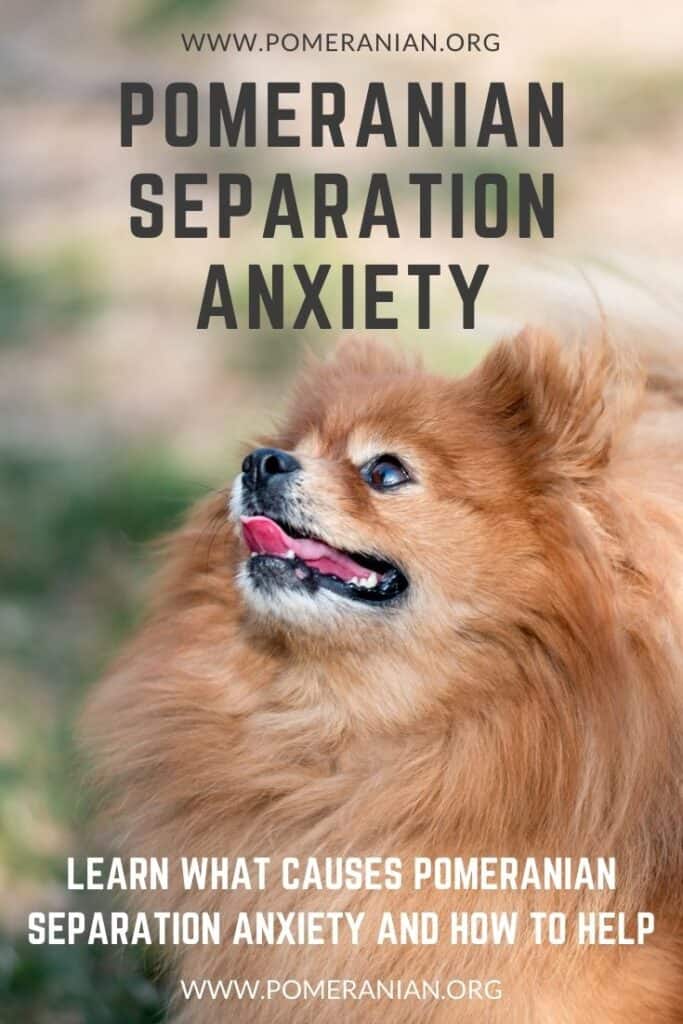Last Updated on 25/04/2024 by Denise Leo. Post first published on November 27, 2023.
If you’re a pet buyer, you may wonder whether or not Pomeranian separation anxiety is something you need to worry about. After all, this dog breed is generally known for being friendly and good with people.
However, even the friendliest dog breeds can experience separation anxiety alone. This blog post will look at what to do if your dog does develop separation anxiety, how to spot it in your Pomeranian, and what owners can do to help your dog overcome it. So read on to learn more!
Pomeranian separation anxiety is worse for your Pom than just missing you. It causes mental and physical stress, but there are ways to reduce and improve the situation.
Do Pomeranians Have Separation Anxiety?
Pomeranian Separation Anxiety Indicators:
Before You Leave:
- Nervous pacing up and down.
- Trembling.
- Acting clingy.
- Pomeranian excessive barking.
- Reacting to your keys jangling.
After You Have Gone:
- He barks excessively until he’s exhausted. Then he rests so he can bark again. A Pomeranian of any age can bark for hours or until he’s hoarse. Neighbors will let you know what they hear.
- Frantic behavior. While he may only feel mild anxiety when you shut the door, if you’re gone for the day, it will build to a point where he becomes frenzied. He might bounce off the walls, claw at the gates, and desperately try to escape. Toys may be tossed around, food and water may be spilled, and he might scratch the walls, causing damage to the house and himself.
- Destructive chewing. It’s different from boredom chewing. He’ll chew anything within reach, often destroying things.
- Urination and defecation. Regardless of how well-trained he is, if he’s extremely stressed and panicked because he’s home alone, he may urinate and defecate anywhere, anytime, with no apparent control. SA can also make him eat his own feces.
- Pomeranian depression. If he’s left at home alone every day, he may become deeply a depressed Pomeranian and not want to do anything until you return.
- Excessive licking. It’s a nervous behavior used to calm himself. However, too much licking can cause hot spots, thin the coat, or create bald patches, potentially causing an infection.
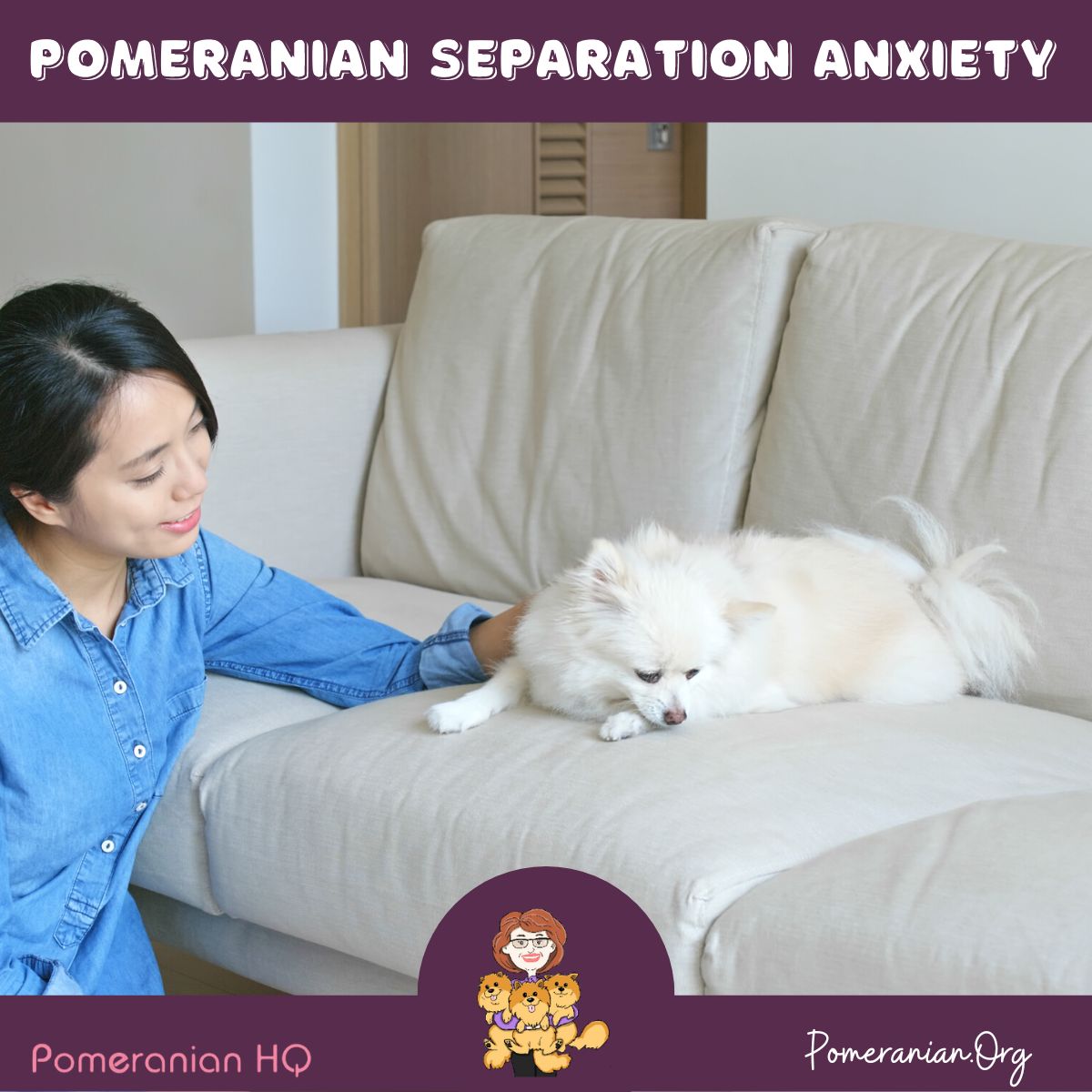
When You Arrive Home:
When you get home, your dog will behave/feel different things, including trembling, trouble remaining calm, emotional exhaustion, excitement, and a rapid release of pent-up energy and emotions (jumping, excessively clingy, circling you, etc.).
Some dogs can’t snap out of their Pomeranian depression and will continue being moody and withdrawn.
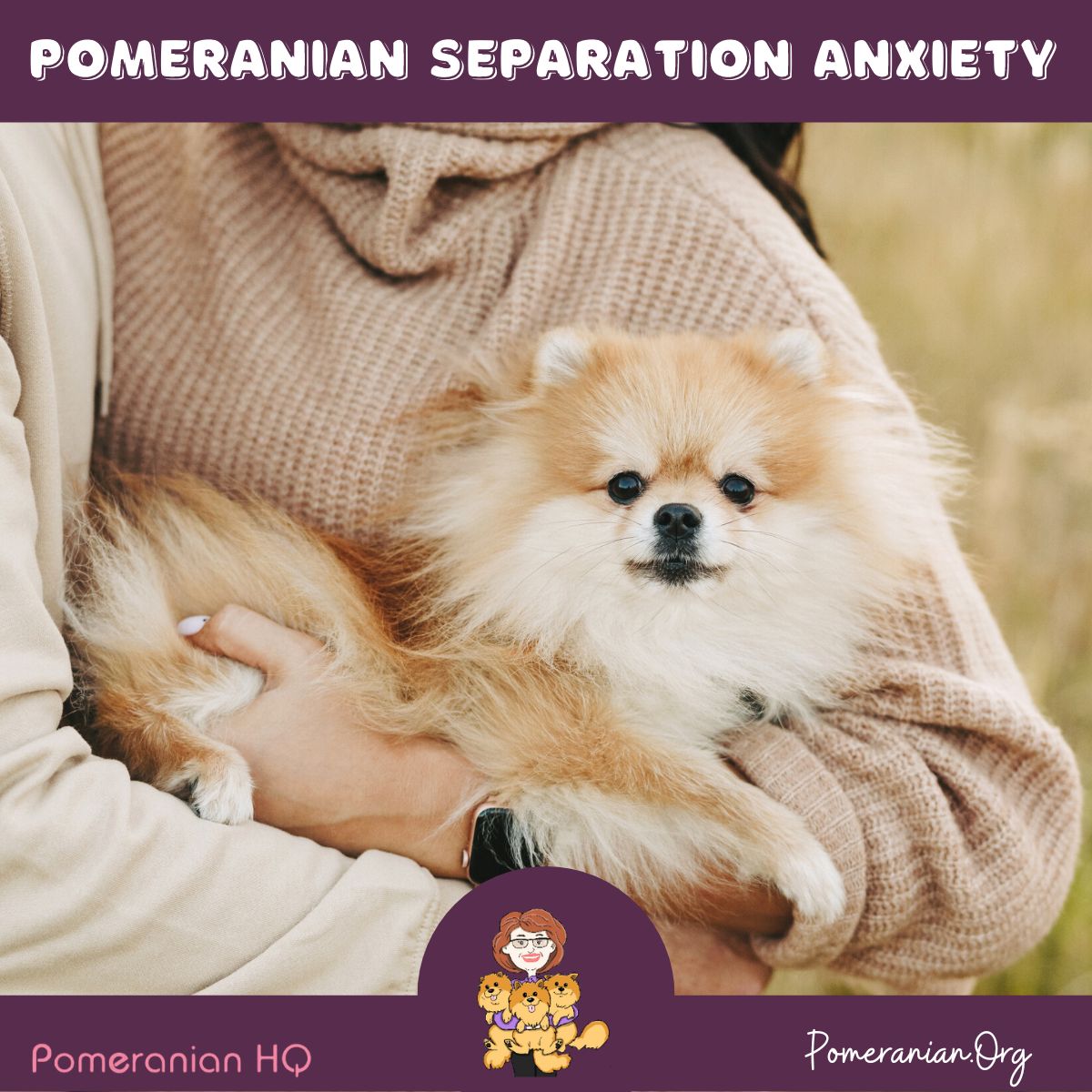
How Long Can a Pomeranian Be Left Alone?
Each Teacup Pomeranian puppy is different. Some Poms experience severe separation anxiety minutes after being left home alone. Others will be fine for short periods (1 or 2 hours), but they’ll have a certain line that, when crossed, causes panic and fear to kick in. Training is always the same.
What Causes Pomeranian Separation Anxiety?
It’s unknown, but it doesn’t vary with gender, age, whether cared for or maltreated, or anything else.
Pomeranian puppies may be okay and then face Pomeranian anxiety as they age. This is because puppies usually live in the current moment, and their minds flit from thought to thought as cognitive recognition isn’t fully developed.
As they mature, self-awareness, understanding of time, and knowing when they’re alone strengthen.
Senior dogs can face Pomeranian dog anxiety, often due to health problems that make them feel vulnerable, and they rely on owners for care more than younger dogs.
Sight and/or hearing loss is a common problem, amplifying separation anxiety.
A high percentage of adopted shelter dogs experience separation anxiety, often due to experiences as a puppy.
If a dog suddenly has separation anxiety, it’s usually because of a life change such as:
- Moving to a new home.
- Getting a new owner.
- A change in his routine or yours.
- The loss of a family member, whether canine, human, or another pet. The loss would be deeply felt if the person were the main caregiver.
- Health problems may vary with age and include kidney disease, UTI, Cushing’s disease, incontinence, leaking bladder, bladder infection, and bladder stones. If your dog has problems, take him to the vet for a thorough Pomeranian anxiety check before training.
Ask the vet if his medications can cause incontinence. If he does his business in the home while you’re away, check it’s not just poor house training.
He can’t hold on if you leave him alone for 10-12 hours. However, his puppy age can tell you how long he can hold it. Three months = 3 hours. 4 = 4 hours and so on.
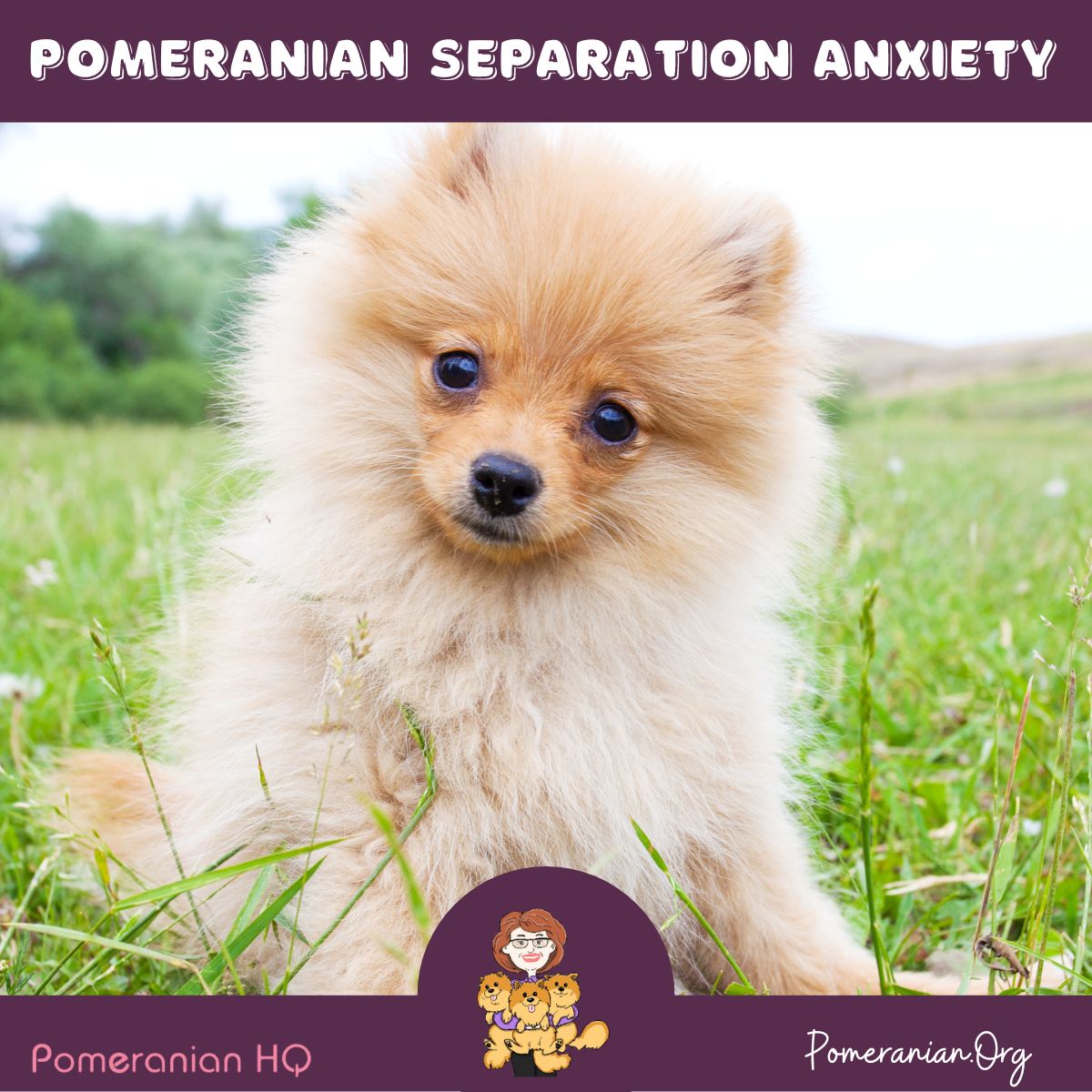
How to Help Pomeranian Separation Anxiety
The solution has several elements. Change how you leave home, ensure his ideal environment, and have practice runs. You may also need Pomeranian anxiety aids.
Each element has numerous sub-elements, but using only a couple won’t do much. If your Pomeranian has separation anxiety, commit to doing as many things as possible.
Pre-departure Pomeranian Training
Whether your Pom demonstrates that he knows you’re leaving or if he’s calm as you exit, all dogs sense their owner is preparing to leave.
These are actions and sounds that need to change before opening that door.
They include:
- Put on your shoes and coat.
- Picking up your keys.
- Opening the door to check the weather.
- Pouring your “to-go” coffee.
The first stage in training is to show your Pom that these things won’t always mean you’re leaving for a long time, or for any time. On days you don’t need to go out, do some of these actions randomly during the day and then carry on with what you were doing.
For example, pick your keys up, jingle them, and then sit and read a book. Another time in the day, open the front door and look at the weather, then shut the door and return to watching TV.
Keep doing these things randomly when you’re not going anywhere because you’re gradually desensitizing your Pom to not see those “cues” as indicators you’re leaving. Once his nervousness fades, he still does one thing daily to keep him calm.
When you do have to leave, here are the guidelines:
- Don’t put your Pom in his designated space (playpen or enclosure with doggie gates) just before leaving. He needs to enjoy his area without believing something “bad” will happen when he’s placed there. When you’re home, leave the gates open and encourage him to go inside to find fun toys and treats. Twenty minutes before leaving, put him in there and close the gate.
- Take him outside to his bathroom before leaving, even if you doubt he needs to go.
- Play with him outside for 15-20 minutes if you have time. (If it’s only 5 minutes, still do it). Running around in the yard or going for his morning walk will help him release energy, so he’s more likely to rest/nap when you’re gone. This helps thwart the dog equivalent of cabin fever.
- Never shower your Pom with hugs and kisses; promise you’ll return. It’s natural to desire this, but it tells him you’ll be gone for a substantial period. Instead, lavish your affections on him 20-30 minutes before you leave. When you’re ready to go, be matter-of-fact. If he seems nervous as you exit, don’t come in to comfort him. The training to come will build his independence skills, and you’ll only counteract them if you come back in to comfort him.
- Never scold him for bad behavior caused by SA. This only increases his stress levels.
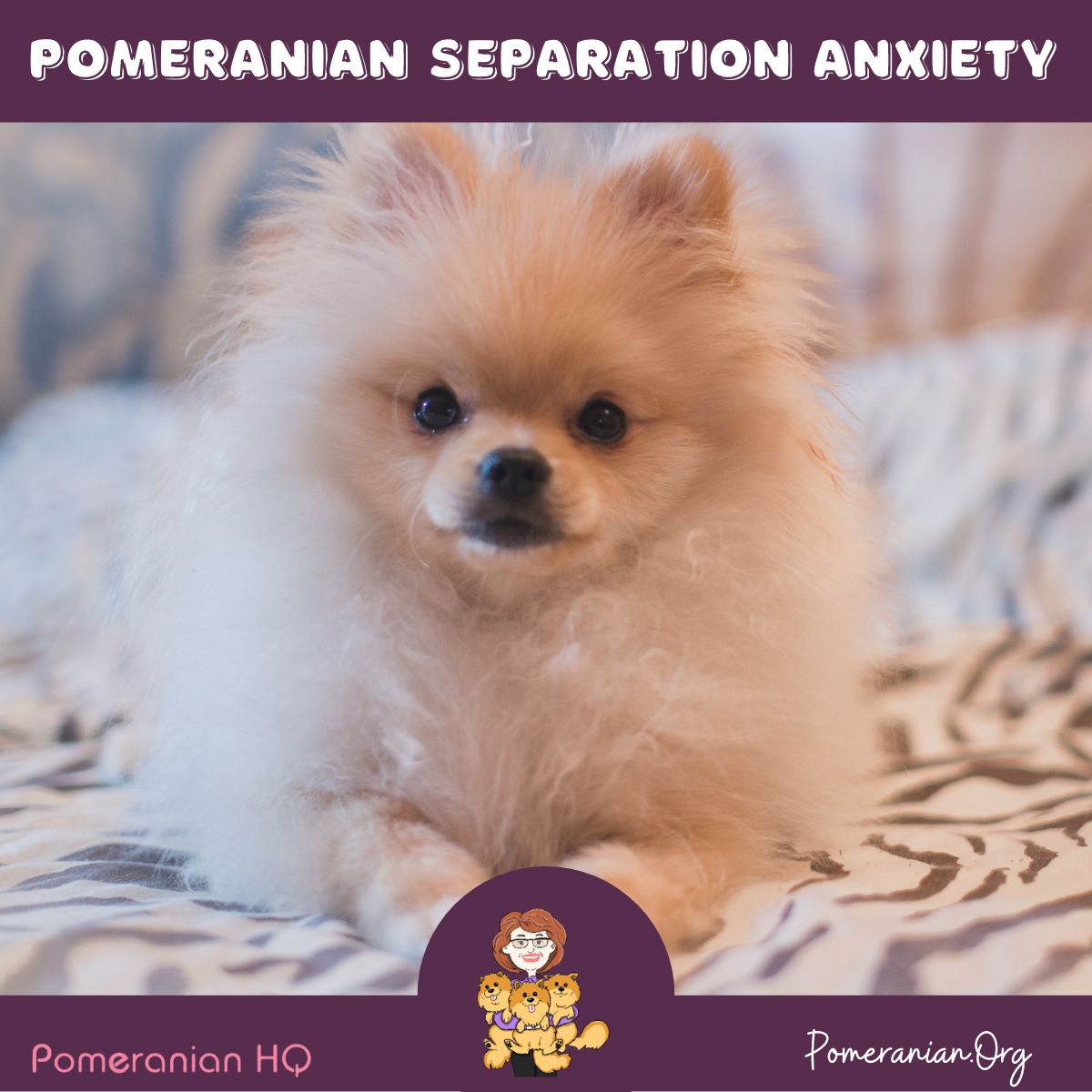
Properly Setting Up His Space
If somebody puts you in a small room with nothing to do, you’ll likely also experience separation anxiety. These tips will ensure he’s safe, keep him occupied, fed, and soothed:
- Ensure the pen or gated area is secure so he can’t escape. It needs to be big enough so he can move around. There should be separate sections for rest/sleep, eating and drinking, playing, and, lastly, for his bathroom needs.
- It must be in a warm, comfortable room with A/C in Summer and a heater in Winter.
- Learn his likes and dislikes. Some like a window view, while others get stressed by it.
Items To Keep In His Area:
Toys – It’s CRITICAL to have plenty of the right puppy separation anxiety toys to help your Pom cope with all the time he spends alone. Some dogs love their favorite companion toy that helps them cope with separation anxiety.
NOTE: See the ‘Care Items – Poms of All Ages’ and ‘Toys’ sections for more information.
Best Pomeranian Dog Separation Anxiety Toys
Water and Food. Use a dispenser instead of a bowl if your Pom keeps spilling the bowl. It’s handy to leave treat-release toys with his food. A mix of kibble and smooth peanut butter can work well.
If you are absent during a scheduled meal, ensure the treat-release toy has enough food for a meal and a snack. If you’re only gone during a snack, leave a snack-sized portion. When he gets hungry, he’ll work for the food, helping him to pass the time.
Doggie Bed. Have a well-cushioned, safe, quality, clean dog bed in his area so he can rest/sleep. If the bed is low quality, making him uncomfortable all day, this will negatively affect him.
Pee-pads. Your Pomeranian may be completely house-trained. However, you’ll need pee-pads if you’re absent longer than he can realistically hold everything in. Even if you doubt he’ll need them, it never hurts to place some “just in case.”
Clothing with your scent. Include a recently worn item of clothing that holds your scent. Whether it’s a shirt, socks, or something else, it shouldn’t be too dirty but unwashed before giving it to your Pomeranian.
Another Essential Factor – Setting Up The Home Environment
Lights. If you compare an empty, well-lit house with an empty, dark one, the lit house offers a better environment. This applies even more if you get home as the sun sets, after dark, or if they forecast clouds or a storm. However, all Poms prefer a well-lit house.
Soothing Noises/Sights. Have a radio or TV playing in the background. Some Poms like it because it resembles noises made when owners are home.
However, some Poms stress if they don’t know where the sounds come from. If this describes your Pom, place a TV within his eyesight. Studies show that dogs watch TV and recognize images.
Your ideal shows are “old school” or family-themed shows such as the Dick Van Dyke show or I Love Lucy. Avoid channels with loud, upset voices, e.g., talk shows airing family arguments.
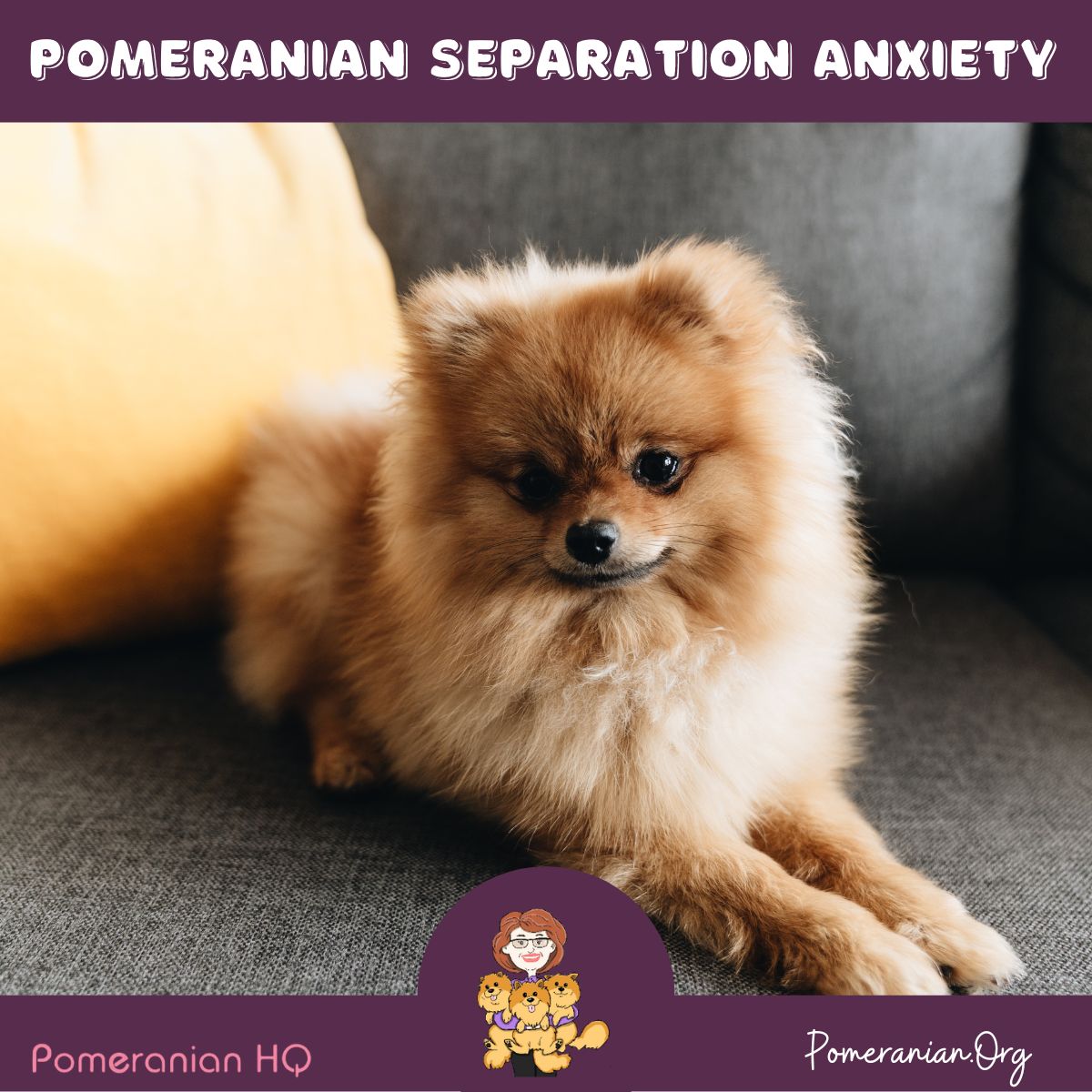
Pomeranian Anxiety Practice Runs
It’s important to do practice runs. If your Pom has severe separation anxiety, train him in baby steps. Using the above guidelines, start training your Pom to adjust to being alone.
Step 1 – Not Leaving.
On days you’re home – follow the departure and environment guidelines and don’t leave the house, but DO leave the room.
Your Pom will be in his designated area with all necessary items. Go to any room where your dog can’t see you…but he can hear you.
No matter how much he whines, cries, jumps, paces, or anything else, stay hidden for 5 minutes and then, very matter-of-factly, re-enter the room. Wait 3 – 5 more minutes, then let him leave his area.
When your Pomeranian learns to be fine with 5 minutes, increase this to 10…then 15, 20, and so on. When he shows no signs of separation anxiety at the 20-minute mark, you’ll be ready for Step 2.
Step 2 – Leaving for Timed Periods.
On days you’re home – follow the departure and environment guidelines. Leave the house just for 10 minutes. Dogs are very intelligent, so it’s best actually to drive away. Do this randomly for one week. On week 2, increase it to 15 minutes. On week 3, increase to 20 minutes. On week 4, increase it to 30 minutes.
Follow these times as closely as possible. The goal will be to show your Pom that he can be alone – and not panicked- for 10 minutes. When he’s confident that he did okay for 10 minutes (which will be greatly helped by following pre-departure guidelines and setting up the right environment), he’ll learn to do just fine for 15 minutes.
Tip. Each dog is unique, and you’ll need to read your Pom’s behavior to see if it’s time to increase these sessions. For some dogs, an increase can be done every few days; for others, it may be every few weeks.
Remember that while this training can take a while, the result will be a confident dog that can handle being home alone, can self-soothe (through the toys and methods mentioned earlier), and will no longer have separation anxiety.
Also, remember that, during the training period, there will be many days when your Pom will be home alone for those 7, 8, or 9 hours.
You can’t do anything about it if you work away from home or are in school, so keep training this way. Once done, these short training sessions will affect how he feels on those long days.

How to Handle Things When You Get Home
When you finally come home after a long day at work, you’ll naturally want to greet your dog and give him big hugs, kisses, and attention. However, when a dog suffers from separation anxiety, making a big deal out of arriving home can be counterproductive.
If you rush inside and straight to your dog to pour it on thick, it’s the same as sending a direct message that says, “I can’t believe I made it back home! Oh, this is a miracle; let’s celebrate!” This tells your dog that he was right to be worried.
So, what should you do? When you enter the home, don’t greet your Pom. This won’t be easy until you get used to the routine. However, it’s best to casually enter, quietly walk to the kitchen, pour a drink of water, check your mail… and then, after 1 to 3 minutes, calmly approach your dog and say “hello.”
After this, take your Pom outside for bathroom needs. Once that’s done, it will be time to hug, kiss, and play! If the weather permits, spend time outside running around with your Pom, allowing him to release pent-up energy and enjoy quality time with you.
Remember, training for separation anxiety doesn’t mean always withholding affection from your Pom. It means holding it back when it does more harm than good.
Additional Help for Pomeranian Separation Anxiety
If you’ll be gone for extended periods of time, it can be helpful to offer your Pom a break in his day. If possible, go home during lunchtime. Even 10 minutes of play and a bathroom break for your Pom can be very helpful.
If this isn’t possible, you may ask a family member, friend, or neighbor if they would like to visit your Pom once daily.
Use a Dog Sitter
Sometimes, older, retired friends, family, or neighbors welcome this request. They enjoy spending time ‘doggie sitting’ and will be more than happy to help.
If you do this, ensure they follow the guidelines for when they leave and that they ensure the designated area holds all of the needed items.
You may consider hiring professional help or a dog walker if you’re normally gone for long periods. Older neighborhood children would love to do this job.
Alternatively, you could ask your local high school’s guidance counselor for suggestions of suitable candidates. If you choose someone, invite them over when you’re home (3 or 4 times on different days), so your Pom can become used to them.
Ensure they follow all the rules and give them your emergency contact number. A mere 30-60 minutes per day when someone comes to your house (to take your Pom outside for a bathroom break and to play with him), will make a huge difference.
Doggie Day Care Might be the Answer to Teacup Pomeranian Separation Anxiety
Many Pom owners with separation anxiety ask if a Doggie Day Care would help. The answer is usually that it all depends on your particular pet. Some dogs love the company of other dogs.
Others aren’t yet socialized with other dogs enough to enjoy playtime, and being away from home overpowers the stress of being home alone.
Teacup Pomeranian Separation Anxiety Supplements & Aids
While they don’t work for every dog and the degree to which they work does vary, some dogs respond very well to calming collars and/or calming supplements.
Our recommended calming collar slowly releases a lavender/chamomile fragrance that naturally relaxes some dogs.
Regarding supplements, those that contain L-theanine and colostrum work very well for some dogs and are safe. L-theanine is an amino acid that has relaxing effects; it doesn’t cause drowsiness;
However, it increases dopamine, an organic chemical released in the brain to regulate mood and relaxation. Colostrum has relaxing properties that reduce stress.
If All Else Fails
Some Pomeranians won’t handle being alone, regardless of what you do. In such cases, medications may be prescribed. However, side effects aren’t worth the benefits except in severe cases. Discuss this with your vet. There are two types of medications most commonly used.
Benzodiazepines (tranquilisers). Negative side effects include sleepiness, increased appetite, and a possible increase in anxiety. Studies show that these can affect the ability to learn and memory.
Monoamine oxidase inhibitors (anti-depressants). Some MAOIs can have dangerous side effects for dogs that have recently ingested cheese products. One well-tolerated drug is Clomicalm.
Although unavailable in all areas, a Certified Applied Animal Behaviourist (CAAB) or a board-certified veterinary behaviorist may help a dog via one-on-one desensitization and conditioning training. This is often expensive, but has worked with some dogs.
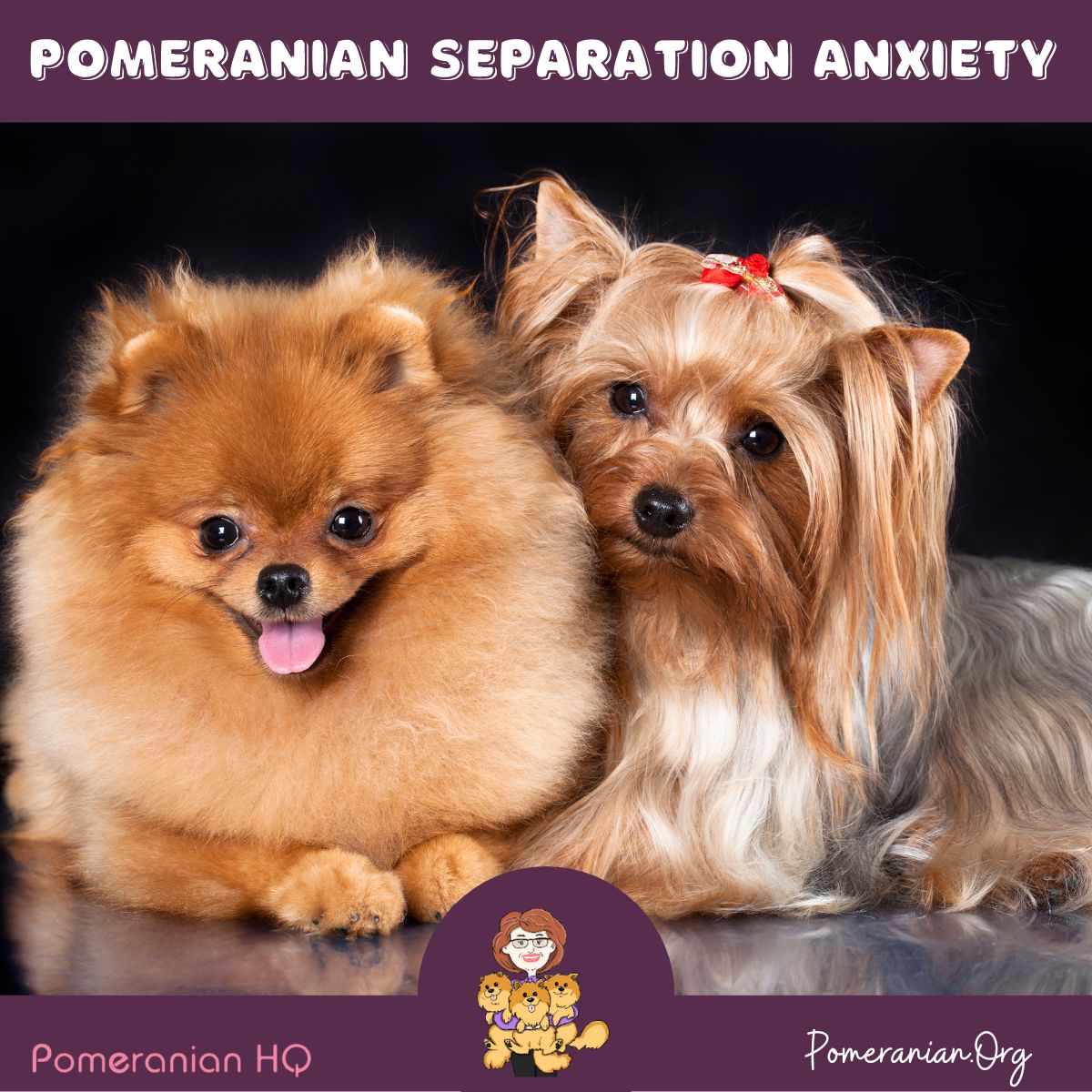
Should You Get Another Pomeranian Dog?
In most cases, when a Pomeranian has another dog for company, this eliminates separation anxiety. However, it’s possible that both dogs won’t cope, or they may have an adjustment period while not getting along enough to offer companionship and comfort.
We never advise someone to take on the responsibility of a second dog for this reason alone. However, if you’ve wanted another dog and have carefully considered the cost and time involved with having multiple pets, this does often help.
Final Thoughts on Dealing With Pomeranian Separation Anxiety
In conclusion, Pomeranian separation anxiety, a common issue in small dog breeds, often manifests through symptoms like destructive behavior, loud noises, and potty accidents. For pet owners, understanding the root of their dog’s anxiety is key to finding solutions.
Firstly, creating a safe space, such as a comfortable living room area or crate training, can provide a secure environment for anxious dogs, especially when left alone for an extended period. Providing interactive toys and a special treat can keep them engaged and less anxiety-prone. Implementing behavioral changes through positive reinforcement is a good idea to encourage good behavior.
Secondly, regular exercise, like a brisk walk, can significantly improve a dog’s mental health and reduce anxiety. For Pomeranians, who are social animals, proper socialization is crucial. Introducing a new dog or scheduling playdates can be effective methods to help your Pomeranian overcome separation anxiety.
Consulting a professional dog trainer or a certified applied animal behaviorist may provide tailored solutions for older dogs or those with a history of health concerns. These experts can suggest techniques like using pheromone diffusers, background noise, or even natural remedies like ginger root, to create a calming environment.
In some cases, a lack of socialization or a major change, such as a change in the previous owner, can trigger anxiety. Addressing these issues through proper training and creating a routine can offer the best results. For pet owners who must leave their Pomeranian home for a long time, employing a pet sitter or using a pet camera can ensure their Pom Pom is not left in a panic attack.
If your Pomeranian is experiencing separation anxiety, there are things you can do to help. Try gradually getting them used to being away from you by starting with short absences and working up to longer ones.
Dog owners can also create a “safe place” for your Pomeranian dog to go when feeling anxious or scared. Finally, ensure you provide plenty of exercise and stimulation throughout the day so your dog doesn’t get bored or restless when left alone.
Remember that every Pomeranian is unique. What works for one may not work for another. The most important actions are to be patient, understand the common signs of anxiety, and try various healthy ways to alleviate their distress. The good news is, with time and effort, most Pomeranians can lead a healthy life free of the symptoms of separation anxiety.
You should be able to help your Pomeranian overcome their separation anxiety with patience and effort.
Has your Pom ever suffered from separation anxiety? What methods did you use to help them feel better?
Copyright Pomeranian.Org. All Rights Reserved.
References and Further Reading:
[1] Denise Leo “The Pomeranian Handbook”.
Best Pomeranian Dog Separation Anxiety Toys
